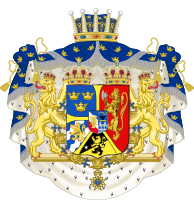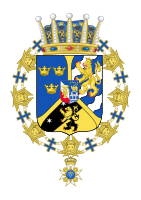Prince Carl, Duke of Västergötland
| Prince Carl | |||||
|---|---|---|---|---|---|
Duke of Västergötland | |||||
 | |||||
| Born | (1861-02-27)27 February 1861 Arvfurstens palats, Stockholm, Sweden | ||||
| Died | 24 October 1951(1951-10-24) (aged 90) Stockholm, Sweden | ||||
| Spouse | Princess Ingeborg of Denmark (m. 1897) | ||||
| Issue |
| ||||
| |||||
| House | Bernadotte | ||||
| Father | Oscar II of Sweden | ||||
| Mother | Sophia of Nassau | ||||
Prince Carl of Sweden and Norway, Duke of Västergötland (27 February 1861 – 24 October 1951) was a Swedish prince. Through his daughters, for whom he arranged excellent dynastic marriages, he is an ancestor of several members of European royal houses today, including the reigning monarchs King Harald V of Norway, King Philippe of Belgium, and Grand Duke Henri of Luxembourg.
Contents
1 Early life
2 Marriage and children
3 Candidate to the Norwegian throne
4 Legacy
5 Titles, styles and arms
6 Ancestry
7 References
8 External links
Early life
Carl was the third son and child of King Oscar II of Sweden-Norway by his wife, Sophia of Nassau. He was known as "the Blue Prince" (Blå Prinsen) because he often wore the blue-coloured uniform of the Life Regiment, to which he belonged in a ceremonial manner.[1]
Marriage and children
In May 1897, Prince Carl was engaged to Princess Ingeborg of Denmark, the second daughter of King Frederick VIII of Denmark. Ingeborg's mother, Louise of Sweden, was a first cousin of Prince Carl. Nevertheless, in 1947, on the occasion of their 50th wedding anniversary, Carl admitted that their marriage had been completely arranged by their respective fathers, and Ingeborg herself added : "I married a complete stranger!".
The couple were married on 27 August 1897 at Christiansborg Palace in Copenhagen and spent their wedding trip (honeymoon) in Germany. The marriage, arranged by their fathers and completely conventional in every way, was entirely harmonious. The couple had four children:
Margaretha (1899–1977), who married Prince Axel of Denmark
Märtha (1901–1954), wife of Crown Prince Olav of Norway and mother of Harald V of Norway
Astrid (1905–1935), wife of Leopold III of Belgium and mother of kings Baudouin and Albert II of Belgium, as also of Grand Duchess Joséphine Charlotte of Luxembourg.
Carl, Duke of Östergötland, known as Carl Jr., later Prince Bernadotte (1911–2003).
Growing up in a conventional and harmonious family, and inculcated with traditional family values in their childhood, all of Carl's children grew up to be happy and constructive adults, healthy in mind and body. While all three daughters made dynastic marriages that were encouraged by their parents, and became the matriarchs of their own successful families, the couple's only son gave up his (highly improbable) chance of succeeding to the throne to marry a noblewoman, with whom he did have a successful marriage.
Styles of Prince Carl of Sweden | |
|---|---|
| Reference style | His Royal Highness |
| Spoken style | Your Royal Highness |
| Alternative style | Sir |
Candidate to the Norwegian throne
In 1905, during the political struggle in which Norway obtained its independence from Sweden, Prince Carl was seriously considered as a candidate for the Norwegian crown. It was thought that electing a Swedish prince as king was a less radical way for Norway to secede from the union, and hence a more peaceful approach. Carl was chosen because his eldest brother would inherit the Swedish throne, and his second brother had renounced his royal status to make an unsuitable marriage. However, Carl's father King Oscar II of Sweden did not approve of the proposal, as he saw the whole "riot" which precipitated the Norwegian crisis as a conspiracy and a betrayal against his rights as King of Norway, and he did not want any of his sons to be involved with people who he considered his enemies. Therefore, Prince Carl never became King of Norway. Instead, a Danish prince, Haakon VII, was elected after some diplomatic turbulence. As history turned out however, Prince Carl's daughter, Princess Märtha, married Haakon VII's son, the later King Olav V. The present King Harald V of Norway is hence a grandchild of Prince Carl, Duke of Västergötland.
In 1904, Prince Carl was appointed a Knight of the Norwegian Lion by Oscar II.
Legacy
Prince Carl has the distinction of being a grandfather of three reigning European monarchs: King Harald V of Norway (son of his daughter, Princess Märtha), the late King Baudouin of Belgium and his brother, King Albert II of Belgium (sons of his daughter, Princess Astrid of Sweden). He is also a great-grandfather of King Philippe of Belgium and Grand Duke Henri of Luxembourg.
Titles, styles and arms
1861–1905: HRH Prince Carl, The Duke of Västergötland, Prince of Sweden and Norway
1905–1951: HRH Prince Carl, The Duke of Västergötland, Prince of Sweden

Arms as Prince of Sweden and Norway, Duke of Västergötland 1861 to 1905

Arms as Prince of Sweden and Duke of Västergötland after 1907
Ancestry
.mw-parser-output table.ahnentafelborder-collapse:separate;border-spacing:0;line-height:130%.mw-parser-output .ahnentafel trtext-align:center.mw-parser-output .ahnentafel-tborder-top:#000 solid 1px;border-left:#000 solid 1px.mw-parser-output .ahnentafel-bborder-bottom:#000 solid 1px;border-left:#000 solid 1px
| Ancestors of Prince Carl, Duke of Västergötland | ||||||||||||||||||||||||||||||||||||||||||||||||||||||||||||||||||||||||||||||||||||||||||||||||||||||||||||||||||||||||||||||||||||||||||||||||||||||||||||||||||||||||||||||||||||||||||||||||||||||||||||||||||||||||||||||||||||||||||||||||||||||||||||||||||||||||||||||||||||||||||||||||||||||||||||||||||||||||||||||||||||||||||||||||||||||||||||||||||||||||||||||||||||||||||||||||||||||||||||||||||||||||||||||||||||||||||||||||||||||||||||||||||||||||||||||||||||||||||||||||||||||||||||||||||||||||||||||||||||||||||||||||||||||||||||||||||||||||||||||||||||||||||||||||||||||||||||||||
|---|---|---|---|---|---|---|---|---|---|---|---|---|---|---|---|---|---|---|---|---|---|---|---|---|---|---|---|---|---|---|---|---|---|---|---|---|---|---|---|---|---|---|---|---|---|---|---|---|---|---|---|---|---|---|---|---|---|---|---|---|---|---|---|---|---|---|---|---|---|---|---|---|---|---|---|---|---|---|---|---|---|---|---|---|---|---|---|---|---|---|---|---|---|---|---|---|---|---|---|---|---|---|---|---|---|---|---|---|---|---|---|---|---|---|---|---|---|---|---|---|---|---|---|---|---|---|---|---|---|---|---|---|---|---|---|---|---|---|---|---|---|---|---|---|---|---|---|---|---|---|---|---|---|---|---|---|---|---|---|---|---|---|---|---|---|---|---|---|---|---|---|---|---|---|---|---|---|---|---|---|---|---|---|---|---|---|---|---|---|---|---|---|---|---|---|---|---|---|---|---|---|---|---|---|---|---|---|---|---|---|---|---|---|---|---|---|---|---|---|---|---|---|---|---|---|---|---|---|---|---|---|---|---|---|---|---|---|---|---|---|---|---|---|---|---|---|---|---|---|---|---|---|---|---|---|---|---|---|---|---|---|---|---|---|---|---|---|---|---|---|---|---|---|---|---|---|---|---|---|---|---|---|---|---|---|---|---|---|---|---|---|---|---|---|---|---|---|---|---|---|---|---|---|---|---|---|---|---|---|---|---|---|---|---|---|---|---|---|---|---|---|---|---|---|---|---|---|---|---|---|---|---|---|---|---|---|---|---|---|---|---|---|---|---|---|---|---|---|---|---|---|---|---|---|---|---|---|---|---|---|---|---|---|---|---|---|---|---|---|---|---|---|---|---|---|---|---|---|---|---|---|---|---|---|---|---|---|---|---|---|---|---|---|---|---|---|---|---|---|---|---|---|---|---|---|---|---|---|---|---|---|---|---|---|---|---|---|---|---|---|---|---|---|---|---|---|---|---|---|---|---|---|---|---|---|---|---|---|---|---|---|---|---|---|---|---|---|---|---|---|---|---|---|---|---|---|---|---|---|---|---|---|---|---|---|---|---|---|---|---|---|---|---|---|---|---|---|---|---|---|---|---|---|---|---|---|---|---|---|---|---|---|---|---|---|---|---|---|---|---|---|---|---|---|---|---|---|---|---|---|---|---|---|---|---|---|---|---|---|---|---|---|---|---|---|---|---|---|---|---|---|---|---|---|---|---|---|---|---|---|---|---|---|---|---|---|---|---|---|---|---|---|---|---|---|---|---|---|---|---|---|---|---|---|---|---|---|---|---|---|---|---|---|---|---|---|---|---|---|---|---|---|---|---|---|---|---|---|---|---|---|---|
| ||||||||||||||||||||||||||||||||||||||||||||||||||||||||||||||||||||||||||||||||||||||||||||||||||||||||||||||||||||||||||||||||||||||||||||||||||||||||||||||||||||||||||||||||||||||||||||||||||||||||||||||||||||||||||||||||||||||||||||||||||||||||||||||||||||||||||||||||||||||||||||||||||||||||||||||||||||||||||||||||||||||||||||||||||||||||||||||||||||||||||||||||||||||||||||||||||||||||||||||||||||||||||||||||||||||||||||||||||||||||||||||||||||||||||||||||||||||||||||||||||||||||||||||||||||||||||||||||||||||||||||||||||||||||||||||||||||||||||||||||||||||||||||||||||||||||||||||||
References
^ http://www.ne.se/uppslagsverk/encyklopedi/lång/blå-prinsen
- Bomann-Larsen, Tor: Folket – Haakon & Maud II (2004; in Norwegian)
External links
Newspaper clippings about Prince Carl, Duke of Västergötland in the 20th Century Press Archives of the German National Library of Economics (ZBW)
Prince Carl, Duke of Västergötland House of Bernadotte Born: 27 February 1861 Died: 24 October 1951 | ||
Swedish royalty | ||
|---|---|---|
New title | Duke of Västergötland 1861–1951 | Vacant Title next held by Crown Princess Victoria of Sweden |


